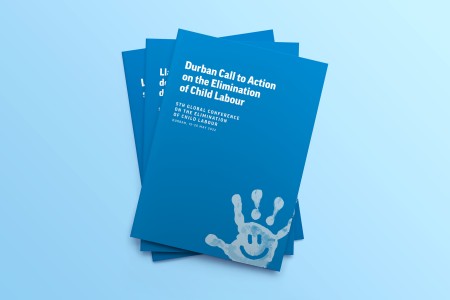
What is the Durban Call to Action?
What is the Durban Call to Action?

The Durban Call to Action is a document that emphasizes the need for urgent action to end child labour. It was adopted by Delegates at the 5th Global Conference on the Elimination of Child Labour on 20 May 2022.
Its goal is to accelerate progress on ending child labour, after years of reversal due to the consequences of the COVID-19 pandemic and other global vulnerabilities.
To achieve the shared goal of zero child labour, thousands of Delegates from governments, workers’ and employers’ organizations, UN agencies, civil society and regional organizations agreed to focus on specific key areas, including child labour in agriculture, children’s rights to education, and universal access to social protection.
The Durban Call to Action is a landmark in the movement against child labour because, for the first time, children are signatories to the document and made clear their expectations for decision-makers to step up their efforts. The event was also special because it was the first to be held in Africa.
How does the Durban Call to Action work?
Implementation of the Durban Call to Action requires immediate, intensified, gender-responsive, well-coordinated, multi-sectoral, multi-stakeholder, and rights-based action to scale up efforts to eliminate child labour.
The Durban Call to Action is guided by the Sustainable Development Goals, a 15-year cycle of increasingly ambitious action to build a better, more equal world. Specifically, SDG target 8.7 says that all UN Member States will take measures to end child labour in all its forms by 2025.
To that effect, the Durban Call to Action commits Member States to tracking their own progress during the period 2022 to 2025 and present the results at the 6th Global Conference on the Elimination of Child Labour. They also agree to share information on good practices based on lessons learned and evidence from national and regional initiatives.
What’s inside?
The Durban Call to Action includes commitments in six different areas:
- Make decent work a reality for adults and youth above the minimum age for work by accelerating multi-stakeholder efforts to eliminate child labour, with priority given to the worst forms of child labour.
- End child labour in agriculture.
- Strengthen the prevention and elimination of child labour, including its worst forms, forced labour, modern slavery and trafficking in persons, and the protection of survivors through data-driven and survivor-informed policy and programmatic responses.
- Realize children’s right to education and ensure universal access to free, compulsory, quality, equitable and inclusive education and training.
- Achieve universal access to social protection.
- Increase financing and international cooperation for the elimination of child labour and forced labour.
How are delegates supporting one another?
Member States cannot eliminate child labour by working alone. According to the ILO’s tripartite structure, governments, employers’ organizations and workers’ organizations will work together to implement the Durban Call to Action, learning from one another and supporting shared goals.
In addition, civil society organizations, including women’s rights organizations, the private sector, and other entities, such as survivor leaders and small producers’ organizations, will take measures within their own competence to support and work together with tripartite partners. Together, all stakeholders will scale up good practices and innovative ideas to achieve the elimination of child labour.
How are we tracking progress?
Starting now, countries must submit their plans for the elimination of child labour known as National Action Plans (NAPs) to the ILO’s centralized repository. This way, the ILO will be able to track and scale up the plans, efforts and achievements of countries around the world.
NAPs are guided by ILO Conventions, which require ILO Member States to design and implement plans to eliminate the worst forms of child labour, and then create national policies to ensure the effective abolition of child labour.
What have we achieved so far?
Cynthia Samuel-Olonjuwon, ILO Assistant Director-General and Regional Director for Africa, says that we have millions of reasons to be optimistic about ending child labour – one for every child in child labour today.
There have been some major wins in the fight to end child labour over the years. For example, in 1999, the Worst Forms of Child Labour Convention became the ILO’s most rapidly ratified Convention in history. Decisive strides made by governments, employers’ organizations and workers’ organizations resulted in a decline in child labour of 86 million since 2000. And all Global Conferences on the Elimination of Child Labour have led to ratifications of ILO child labour conventions, major funding commitments, and tangible interventions for the elimination of child labour.
By 2030, we could reduce child labour further still. We just need to focus on the six key areas outlined in the Durban Call to Action. We must act on the root causes of child labour, including expanding education and social protection for all. And we must continue to call for action.
That’s why we will focus on the critical importance of ending child labour everywhere, immediately.
Raise your hand for kids!
Take action for kids by raising your hand. We challenge YOU to share this message on social media:
“I invite (tag 3 people) to raise their hands for a world free from child labour, in line with the Durban Call to Action.”
Add a photo and use the hashtag #RaiseYourHandForKids.
Every action counts. Together, we can end child labour



